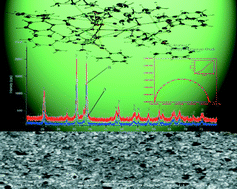Heterobimetallic molecular precursors [Ti4(dmae)6(µ-OH)(µ-O)6Cu6(benzoate)9] (1) and [Ti4(dmae)6(µ-OH)(µ-O)6Cu6(2-methylbenzoate)9] (2) were prepared by the interaction of Ti(dmae)4 [dmae = N,N-dimethylaminoethanolate] with Cu(benzoate)2·2H2O for (1) and Cu(2-methylbenzoate)2·2H2O for (2), respectively, in dry toluene, for selective deposition of Cu/Ti oxide thin films for possible technological applications. Both the complexes were characterized by melting point, elemental analysis, FT-IR, thermal analysis and single crystal X-ray analysis. Complex (1) crystallizes in the triclinic space group P-1 and complex (2) in the rhombohedral space group R-3. The TGA analysis proves that complexes (1) and (2) undergo facile thermal decomposition at 550 °C to form copper titanium mixed metal oxides. The SEM/EDX and XRD analyses suggest the formation of carbonaceous impurity free good quality thin films of crystalline mixtures of β-Cu3TiO4 and TiO2 for both (1) and (2), with average grain sizes of 0.29 and 0.74 µm, respectively. Formation of two different homogenously dispersed oxide phases is also supported by electrical impedance measurements.

You have access to this article
 Please wait while we load your content...
Something went wrong. Try again?
Please wait while we load your content...
Something went wrong. Try again?


 Please wait while we load your content...
Please wait while we load your content...